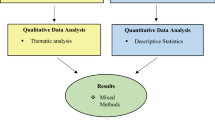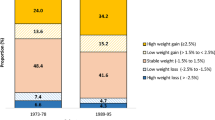Abstract
Objective:
To investigate sociodemographic and behavioural characteristics associated with weight status among women with children living in socioeconomically disadvantaged neighbourhoods.
Methods and procedures:
A total of 1680 women aged 18–46 years, living in socioeconomically disadvantaged neighbourhoods with dependent children (aged 0–18 years), provided self-report data on height and weight and a range of sociodemographic and behavioural (for example, dietary intake, physical activity and time spent sitting) characteristics.
Results:
Half of the women were classified as having a healthy weight (body mass index=18.5–25). Bivariable ordinal logistic regression analyses indicated that a healthy weight status was associated with a range of sociodemographic and behavioural characteristics. In a multivariable model, a healthy weight status among women was associated with being younger and unmarried, speaking a language other than English at home, having a medium or high level of education, and a partner with a high level of education, having a high household income, spending more time engaged in leisure-time physical activity and less time spent sitting, and having a lower consumption of soft drink.
Discussion:
The present findings highlight that a considerable proportion of women with children living in disadvantaged neighbourhoods manage to maintain a healthy weight. Acknowledging the cross-sectional nature of this study, strategies aimed at helping women with children in socioeconomically disadvantaged areas to maintain their weight should focus on increasing physical activity, and reducing sitting time and soft drink consumption.
This is a preview of subscription content, access via your institution
Access options
Subscribe to this journal
Receive 12 print issues and online access
$259.00 per year
only $21.58 per issue
Buy this article
- Purchase on Springer Link
- Instant access to full article PDF
Prices may be subject to local taxes which are calculated during checkout
Similar content being viewed by others
References
World Health Organization. Obesity: prevention and managing the global epidemic. Report on a WHO consultation. World Health Organization: Geneva, 1998. WHO Technical Report Series 894.
Ball K, Crawford D, Ireland P, Hodge A . Patterns and demographic predictors of 5-year weight change in a multi-ethnic cohort of men and women in Australia. Public Health Nutr 2003; 6: 269–280.
Ball K, Brown W, Crawford D . Who does not gain weight? Prevalence and predictors of weight maintenance in young women. Int J Obes 2002; 26: 1570–1578.
Williamson DF, Kahn HS, Byers T . The 10-y incidence of obesity and major weight gain in black and white US women aged 30–55 y. Am J Clin Nutr 1991; 53: 1515S–1518S.
Williamson DF, Madans J, Pamuk E, Flegal KM, Kendrick JS, Serdula MK . A prospective study of childbearing and 10-year weight gain in US white women 25 to 45 years of age. Int J Obes Relat Metab Disord 1994; 18: 561–569.
Wolfe WS, Sobal J, Olson CM, Frongillo Jr EA, Williamson DF. Parity-associated weight gain and its modification by sociodemographic and behavioral factors: a prospective analysis in US women. Int J Obes Relat Metab Disord 1997; 21: 802–810.
Smith DE, Lewis CE, Caveny JL, Perkins LL, Burke GL, Bild DE . Longitudinal changes in adiposity associated with pregnancy. The CARDIA Study. Coronary Artery Risk Development in Young Adults Study. JAMA 1994; 271: 1747–1751.
Rookus MA, Rokebrand P, Burema J, Deurenberg P . The effect of pregnancy on the body mass index 9 months postpartum in 49 women. Int J Obes 1987; 11: 609–618.
Bellows-Riecken KH, Rhodes RE . A birth of inactivity? A review of physical activity and parenthood. Prev Med 2008; 46: 99–110.
George GC, Milani TJ, Hanss-Nuss H, Freeland-Graves JH . Compliance with dietary guidelines and relationship to psychosocial factors in low-income women in late postpartum. J Am Diet Assoc 2005; 105: 916–926.
Ball K, Crawford D, Warren N . How feasible are healthy eating and physical activity for young women? Public Health Nutr 2004; 7: 433–441.
Ellaway A, Anderson A, Macintyre S . Does area of residence affect body size and shape? Int J Obes 1997; 21: 304–308.
Harrington DW, Elliott SJ . Weighing the importance of neighbourhood: a multilevel exploration of the determinants of overweight and obesity. Soc Sci Med 2009; 68: 593–600.
Ball K, Crawford D, Mishra G . Socio-economic inequalities in women′s fruit and vegetable intakes: a multilevel study of individual, social and environmental mediators. Public Health Nutr 2006; 9: 623–630.
Gidlow C . A systematic review of the relationship between socio-economic position and physical activity. Health Educ J 2006; 65: 338–367.
Crespo CJ, Ainsworth BE, Keteyian SJ, Heath GW, Smit E . Prevalence of physical inactivity and its relation to social class in US. adults: results from the Third National Health and Nutrition Examination Survey 1988–1994. Med Sci Sports Exerc 1999; 31: 1821–1827.
Inglis V, Ball K, Crawford D . Why do women of low socioeconomic status have poorer dietary behaviours than women of higher socioeconomic status? A qualitative exploration. Appetite 2005; 45: 334–343.
Johansson L, Thelle DS, Solvoll K, Bjørneboe GE, Drevon CA . Healthy dietary habits in relation to social determinants and lifestyle factors. Br J Nutr 1999; 81: 211–220.
Shrewsbury V, Garnett S, Cowell C, Crawford D, Baur L . Change in women′s body mass index and waist circumference, 1997 to 2002: The Nepean Study. Aust NZ J Public Health 2005; 29: 183–186.
Ball K, Crawford D . Socio-economic factors in obesity: a case of slim chance in a fat world? Asia Pac J Clin Nutr 2006; 15: 15–20.
Australian Bureau of Statistics. 2001 Census of Population and Housing—SEIFA, 2001. (http://www.abs.gov.au/AUSSTATS/abs@.nsf/allprimarymainfeatures/C53F24374E92E8D3CA2573F0000DA0BE?opendocument) Accessed on 5 November 2008.
Gorber SC, Tremblay M, Moher D, Gorber B . A comparison of direct vs. self-report measures for assessing height, weight and body mass index: a systematic review. Obes Rev 2007; 8: 307–326.
Krieger N, Williams DR, Moss NE . Measuring social class in US public health research: concepts, methodologies, and guidelines. Annu Rev Public Health 1997; 18: 341–378.
Turrell G . Income non-reporting: implications for health inequalities research. J Epidemiol Community Health 2000; 54: 207–214.
Craig CL, Marshall AL, Sjostrom M, Bauman AE, Booth ML, Ainsworth BE et al. International physical activity questionnaire: 12-country reliability and validity. Med Sci Sports Exerc 2003; 35: 1381–1395.
Marks G, Webb K, Rutishauser I, Riely M . Monitoring Food Habits in the Australian Population Using Short Questions. Commonwealth of Australia: Canberra, 2001.
Riley M, Rutishauser IHE, Webb K . Comparison of Short Questions with Weighed Dietary Records. Australian Food and Nutrition Monitoring Unit: Canberra, 2001.
McLennan W, Podger A . National Nutrition Survey User's Guide 1995. AGPS: Canberra, 1998.
Rutishauser IHE, Webb K, Abraham B, Allsopp R . Evaluation of Short Dietary Questions from the 1995 National Nutrition Survey. National Food and Nutrition Monitoring and Surveillance Project. Commonwealth Department of Health and Aged Care: Canberra, 2001.
Sanigorski AM, Bell AC, Swinburn BA . Association of key foods and beverages with obesity in Australian schoolchildren. Public Health Nutr 2007; 10: 152–157.
Hodge A, Patterson AJ, Brown WJ, Ireland P, Giles G . The Anti Cancer Council of Victoria FFQ: relative validity of nutrient intakes compared with weighed food records in young to middle-aged women in a study of iron supplementation. Aust NZ J Public Health 2000; 24: 576–583.
Willett W . Nutritional Epidemiology. Oxford University Press: New York, 1998.
Ball K, Mishra GD, Thane CW, Hodge A . How well do Australian women comply with dietary guidelines? Public Health Nutr 2004; 7: 443–452.
Hu FB, Rimm EB, Stampfer MJ, Ascherio A, Spiegelman D, Willett WC . Prospective study of major dietary patterns and risk of coronary heart disease in men. Am J Clin Nutr 2000; 72: 912–921.
Dillman D . Mail and Telephone Surveys: The Total Design Method. Wiley: New York, 1978.
Scott SC, Goldberg MS, Mayo NE . Statistical assessment of ordinal outcomes in comparative studies. J Clin Epidemiol 1997; 50: 45–55.
Lipowicz A, Gronkiewicz S, Malina RM . Body mass index, overweight and obesity in married and never married men and women in Poland. Am J Hum Biol 2002; 14: 468–475.
Sobal J, Rauschenbach B, Frongillo EA . Marital status changes and body weight changes: a US longitudinal analysis. Soc Sci Med 2003; 56: 1543–1555.
Jeffery RW, Rick AM . Cross-sectional and longitudinal associations between body mass index and marriage-related factors. Obes Res 2002; 10: 809–815.
Ball K, Crawford D . Socioeconomic status and weight change in adults: a review. Soc Sci Med 2005; 60: 1987–2010.
Fogelholm M, Kukkonen-Harjula K . Does physical activity prevent weight gain—a systematic review. Obes Rev 2000; 1: 95–111.
Catenacci VA, Wyatt HR . The role of physical activity in producing and maintaining weight loss. Nat Clin Pract Endocrinol Metab 2007; 3: 518–529.
Malik V, Schulze M, Hu F . Intake of sugar-sweetened beverages and weight gain: a systematic review. Am J Clin Nutr 2006; 84: 274–288.
Johansson L, Solvoll K, Bjorneboe GE, Drevon CA . Under- and overreporting of energy intake related to weight status and lifestyle in a nationwide sample. Am J Clin Nutr 1998; 68: 266–274.
Acknowledgements
This study was funded by an Australian National Health and Medical Research Council Strategic Award (#374241). The authors gratefully acknowledge the contributions of the project manager Dr Michelle Jackson, the field staff, and the study participants. Abbie MacFarlane is supported by a National Health and Medical Research Council Capacity Building Grant, David Crawford is supported by a VicHealth Senior Public Health Research Fellowship and Kylie Ball is supported by National Health and Medical Research Council Senior Research Fellowship (#479513).
Author information
Authors and Affiliations
Corresponding author
Rights and permissions
About this article
Cite this article
MacFarlane, A., Abbott, G., Crawford, D. et al. Sociodemographic and behavioural correlates of weight status among women with children living in socioeconomically disadvantaged neighbourhoods. Int J Obes 33, 1289–1298 (2009). https://doi.org/10.1038/ijo.2009.167
Received:
Revised:
Accepted:
Published:
Issue Date:
DOI: https://doi.org/10.1038/ijo.2009.167
Keywords
This article is cited by
-
Do sedentary behaviors mediate associations between socio-demographic characteristics and BMI in women living in socio-economically disadvantaged neighborhoods?
International Journal of Behavioral Nutrition and Physical Activity (2015)
-
Is a perceived supportive physical environment important for self-reported leisure time physical activity among socioeconomically disadvantaged women with poor psychosocial characteristics? An observational study
BMC Public Health (2013)
-
Associations between psychological stress, eating, physical activity, sedentary behaviours and body weight among women: a longitudinal study
BMC Public Health (2013)
-
Resilience to obesity among socioeconomically disadvantaged women: the READI study
International Journal of Obesity (2012)
-
Supermarket Healthy Eating for Life (SHELf): protocol of a randomised controlled trial promoting healthy food and beverage consumption through price reduction and skill-building strategies
BMC Public Health (2011)



